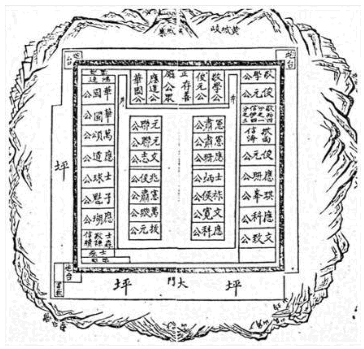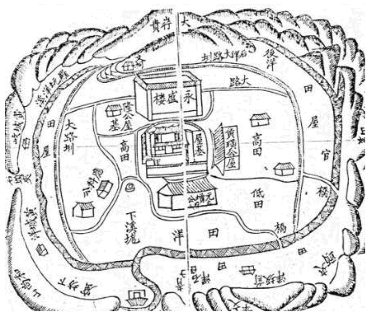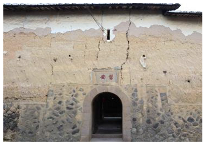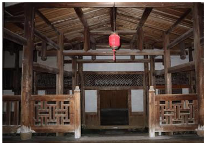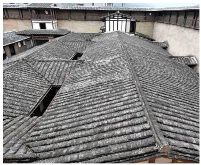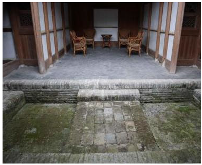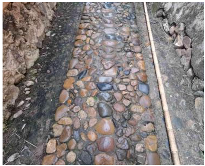Abstract
Scientific evaluation of architectural heritage value constitutes a crucial foundation for advancing effective conservation practices and guiding policy development. Fujian Tubao, a distinctive form of defensive vernacular architecture found in southeastern China, integrates military defense, residential functions, and clan-based social organization into a unified spatial structure, making it an important component of China’s regional cultural heritage. In response to current challenges of inadequate preservation and progressive loss of heritage value associated with Fujian Tubao, there is an urgent need to establish a systematic evaluation framework to support and inform conservation efforts. This study centered on Fujian Tubao and proposed a comprehensive value assessment system that could innovatively integrate Grounded Theory with the Analytic Hierarchy Process (AHP). The Grounded Theory was first adopted to extract value dimensions of architectural heritage and their underlying connotations, thereby forming a value cognition system. Subsequently, the AHP was applied to assign quantitative weights and establish the priority order of each dimension, ultimately constructing a value evaluation system that could identify core objects for heritage conservation and clarify the hierarchy of their relative importance. This study achieved methodological integration in both the value extraction and evaluation stages, overcoming limitations of a single-method approach in dimension identification and weight assignment. The framework ensures logical consistency in value structuring and enhances the scientific validity of results. This study formulated a standardized and replicable evaluation framework tailored to the heritage value of Fujian Tubao. It also provides theoretical support for future conservation planning and offers a methodological reference for value assessment across diverse categories of architectural heritage.
1. Introduction
The genesis and construction of historical edifices, particularly those of a defensive nature, are profoundly shaped by their prevailing historical context. Throughout the millennia of Chinese civilization, conflict has been a recurrent theme in the struggle for finite resources among states, social classes, and clans. This persistent state of strife provided the crucible from which defensive architecture gradually emerged, with its specific forms varying significantly across regions due to local geographical factors [1]. The overlapping mountain ranges and dense river networks in Fujian Province naturally formed a relatively enclosed geographical configuration, which consequently limited the spread of large-scale warfare from the Central Plains into this region. This unique environment, while attracting Han Chinese migrants fleeing conflict in the Central Plains, also contributed to the prevalence of banditry and frequent incursions by marauding groups. Consequently, the local populace driven by the imperative to safeguard their homes developed a need for spaces that were simultaneously secure, defensible, and habitable, leading to the birth of Fujian Tubao [2]. Compared with other well-known defensive structures such as Japan’s Tenshukaku and medieval European castles, Fujian Tubao demonstrates a unique integration of defensive, residential, and clan-based functions. Both Tenshukaku and European castles served as fortified residences for ruling elites and garrisons for professional armed forces, representing a fusion of official residence and military fortress. Tenshukaku emphasizes authority, functioning both as an aesthetic landmark and a symbol of power, while European castles focus on territorial defense and aristocratic control through features such as moats, drawbridges, and massive stone walls. In contrast to these ruler-centric constructions, Fujian Tubao was built collectively by local villagers to resist bandit invasions, with a spatial layout designed to reinforce clan solidarity rather than to assert private dominion. This fundamental difference in user agency was the primary reason for the architectural divergence among these structures [3].
Fujian Tubao constitutes a significant component of the unique defensive architectural heritage found in Fujian Province. It is characterized by key attributes such as rarity, distinctiveness, and strong regional specificity. These structures reflect the ingenuity and strategic responses of local residents to the prevailing geographical environment and social instability during specific historical periods. They also embody a profound amalgamation of traditional Chinese clan culture, communal living patterns, and vernacular construction techniques. Consequently, Fujian Tubao serves as a quintessential exemplar for studying defensive architecture across the Min–Gan–Yue (Fujian, Jiangxi, Guangdong) region [4]. Currently, preservation mechanisms for Fujian Tubao are demonstrably inadequate, resulting in the deterioration and decay of numerous such structures, with a significant loss of their inherent architectural values. Against the backdrop of an increasing emphasis on cultural heritage preservation, precise identification of value-bearing elements for protection and the refinement of value evaluation criteria can serve as both a proactive response to national policies and a pivotal issue within the field of architectural heritage conservation [5]. Value assessment constitutes one of the most crucial components of conservation planning. Positioned at the forefront of understanding what is to be protected, it serves as the fundamental starting point for clarifying the intrinsic significance of heritage, delineating the scope and priorities for conservation, formulating appropriate protective measures, and communicating its cultural meaning [6]. Only through a profound understanding of the value composition of architectural heritage, encompassing the weights of its various values and their intrinsic interconnections, can one accurately differentiate and assess the significance of heritage values and establish prioritized levels of protection [7]. Consequently, this foundational understanding provides a solid basis and targeted approach for the development of technical conservation strategies for architectural heritage [8].
This study introduced both Grounded Theory methodology and the Analytic Hierarchy Process (AHP) into the construction of a value evaluation system for Fujian Tubao architectural heritage. The Grounded Theory was first applied to systematically code and synthesize data gathered from field interviews, thereby extracting value perceptions of Fujian Tubao architectural heritage held by diverse stakeholders, including villagers, administrators, village cadres, and experts. From this qualitative analysis, comprehensive value categories were subsequently derived. Building upon the value cognition system established through the Grounded Theory, the AHP was then employed. This involved constructing pairwise comparison matrices, for which expert evaluations were solicited to assign quantitative weights to the identified value dimensions. This process clarified the relative importance of each value indicator within the overall value framework of Fujian Tubao, culminating in the development of a comprehensive Fujian Tubao architectural heritage value evaluation system. This system, in turn, provides a scientific basis and decision-making reference for subsequent architectural conservation, utilization, and governmental policy formulation.
Compared with previous studies [9,10,11], this research established a two-stage methodological pathway that integrated qualitative grounded theory with quantitative AHP, forming a clear logical link between the two key stages of value identification and value prioritization. By introducing the Grounded Theory to inductively derive value dimensions of Fujian Tubao architectural heritage and using them as the basis for constructing the AHP judgment matrix, the evaluation system ensured traceable origins for the identified value dimensions and enhanced the logical rigor of the weighting assignment. In contrast to traditional single-method approaches that often result in incomplete value dimensions or overly subjective weighting, this study improved the systematization, applicability, and replicability of the evaluation framework, contributing theoretically to the exploration of pluralistic approaches in architectural heritage value assessment.
2. Literature Review
2.1. Research on the Value of Architectural Heritage
Internationally, research on the value of architectural heritage is often situated within the broader framework of cultural heritage studies. Upon recognizing the central importance of value-based heritage conservation, scholars in the field of cultural heritage have undertaken in-depth investigations into the composition and connotations of heritage value [12]. As early as 1902, Austrian art theorist Alois Riegl categorized the values of monuments in chronological terms into two main types: commemorative value and contemporary value. The former includes age value, historical value, and deliberately commemorative value, while the latter refers to use value and artistic value [13]. In 1963, Walter Frodl further classified heritage values into historical commemorative value, artistic value, and use value [14]. In addition to dissecting the heritage value into dimensions such as historical, artistic, and technological aspects, scholars have also actively explored the conceptual distinction between intrinsic and extrinsic values of cultural heritage. This line of inquiry not only focuses on the inherent significance of heritage itself, but also considers its broader functions and impacts in social, cultural, and economic contexts. Since the beginning of the 21st century, with the emergence of new concepts such as cultural landscapes, cultural routes, and canal heritage with continued exploration of material and intangible elements, heritage environments, and the spirit of place, academic understanding of heritage value has become increasingly comprehensive [15]. In 2020, Marta de la Torre examined how the evolving definitions of heritage and heritage value had driven changes in conservation practice. She emphasized that understanding the core and essence of value-based conservation depended on recognizing intrinsic characteristics of heritage value—namely, its assignability, multiplicity, mutability, incommensurability, and inherent contradictions [16].
In recent years, with deepening exploration of cultural heritage value, international scholars have increasingly focused on the application of multi-criteria decision analysis (MCDA) methods to heritage value assessment. MCDA has gradually become a critical tool for value identification and evaluation. Among these, methods such as the AHP, Technique for Order Preference by Similarity to Ideal Solution (TOPSIS), and fuzzy comprehensive evaluation have been widely employed in the prioritization, value management, and policy planning of cultural heritage. In 2020, Della Spina proposed an integrated multi-criteria decision-making model combining AHP, EVAMIX, and MACBETH to evaluate adaptive reuse strategies for historic military fortifications in Italy, emphasizing the pivotal role of cultural heritage’s multidimensional values in fostering participatory and sustainable decision-making [17]. In 2025, Arrighi et al. developed a cultural heritage risk prioritization framework grounded in the concept of social value. By integrating multi-criteria decision analysis (MCDA) with the participatory perspectives of community members, experts, and local authorities, their study enabled quantitative assessment of heritage risk, highlighting an autonomous role of social value in heritage management and challenging the conventional assessment paradigms centered on material attributes [18]. Salehipour et al. have combined AHP and TOPSIS to construct a heritage tourism value model for Iranian cultural sites, showcasing the applicability of MCDA in sustainable tourism decision-making [19]. Similarly, Davies et al. have employed the AHP method to rank reuse strategies for the traditional Nigerian dwelling “Fagbewesa’s House”, using expert scoring to determine priority levels [20]. Their research provided a localized value identification framework for architectural heritage, emphasizing the guiding role of place-based cultural significance in conservation strategies. Overall, these studies collectively reinforced the structured construction of multidimensional indicators and the logic of weight ranking in cultural heritage value assessment. They underscore the methodological importance of MCDA in identifying and evaluating heritage values. In contrast to fragmented approaches found in the existing literature, the present study attempts to propose a novel, integrative framework that bridges multiple methods, thereby addressing the current methodological limitations—namely, the weak theoretical grounding and high subjectivity of indicator systems—in heritage value evaluation.
Since the beginning of the 21st century, Chinese scholars in the field of cultural heritage have developed localized and diversified lines of inquiry, building upon extensive engagement with international research. Their studies on heritage value have primarily focused on the composition of heritage value and methodologies for its evaluation.
2.1.1. Research on the Composition of Architectural Heritage Value
Since the adoption of the Convention Concerning the Protection of the World Cultural and Natural Heritage in 1972, the classification of heritage value has become a central issue in the field of heritage value research. In 2007, Lin Yuan reclassified components of architectural heritage value into three categories: informational value, emotional and symbolic value, and utilitarian value. Informational value includes historical value, artistic value, and scientific–technological value [21]. In 2011, Yu Jia proposed that cultural heritage value consisted of non-quantifiable existence value and quantifiable use value (economic value), each corresponding to different stakeholder groups. Existence value serves as the foundation and prerequisite for use value, while use value represents the economic benefits derived from the development and utilization of existence value [22]. In 2013, Qin Hongling categorized value elements of architectural cultural heritage into two broad types: cultural value and economic value. The former specifically includes historical value, artistic value, scientific value, and cultural–educational value [23]. In 2018, Xu Jinliang, from the perspective of heritage value typology, constructed a value system for architectural heritage. He defined comprehensive value as comprising intrinsic and extrinsic components. Historical, artistic, scientific, and environmental values fall under intrinsic value, whereas social and cultural values are categorized as extrinsic value [24].
2.1.2. Research on Evaluation Methods for Architectural Heritage Value
Due to the complexity and particularity of heritage value, it is unrealistic to identify a universal method capable of evaluating all types of value. Different disciplines, based on their respective theoretical foundations and characteristics of local heritage, have explored evaluation approaches suited to China’s heritage conservation context [25]. Prior to the 1990s, the evaluation of architectural heritage in China was primarily qualitative in nature. In the current stage, with the introduction of statistical methods, the development of quantitative value evaluation systems has gradually become a key research focus. The evaluation of architectural heritage value has evolved to exhibit a trend of methodological diversity, multi-perspective approaches, and interdisciplinary integration. In 2010, Han Bing reviewed the current state of research on architectural heritage value evaluation methods, analyzed factors influencing heritage value, and discussed the potential for introducing multi-criteria evaluation techniques such as the expert scoring method, the Delphi Method, and the AHP into architectural heritage assessment [26]. In 2013, Song Gang integrated the AHP, the Delphi Method, and the entropy weight method to establish a hierarchical model for evaluating the value of modern and contemporary architectural heritage in China and determined relative weights of various sub-indicators. Based on weight allocation results, he concluded that artistic value and historical value should be prioritized in the evaluation of modern and contemporary architectural heritage [27].
2.2. Research on the Value of Fujian Tubao
As a form of traditional Chinese architectural heritage, the study of Fujian Tubao has its origins and development deeply rooted in Chinese academia. To date, this research field has been primarily led by Chinese scholars. Accordingly, this study draws upon literature from the China National Knowledge Infrastructure (CNKI) database to analyze research related to the value of Fujian Tubao. In 2009, Qiu Guopeng, through an analysis of cultural and artistic characteristics of Fujian Tubao, summarized its cultural value as comprising Hakka culture, Confucian ritual culture, and architectural culture. Its artistic value is reflected in the following aspects: the diversity of architectural forms, the natural spatial layout, the scientific nature of construction techniques, and the uniqueness of decorative styles [28]. In 2011, Dai Zhijian argued that as a form of historical and cultural heritage, Fujian Tubao possesses both tangible and intangible heritage value in the field of architecture, including tourism development value in economics and irreplaceable academic research value in cultural geography, cultural anthropology, and cultural sociology—particularly for clarifying the origins and evolution of Chinese civilization and examining the role of Tubao as a public architectural form within regional contexts [29]. In 2024, Wang Huihui, through field investigations and literature analysis, identified heritage value components of the Shuimei Tubao cluster as historical value, artistic value, scientific value, and socio-cultural value. Based on an analysis of current issues facing the Shuimei village, she proposed a set of protection strategies: point-based strategies grounded in prominent value recognition, line-based strategies guided by relational value recognition, and area-based strategies reflecting holistic value recognition [30].
2.3. Review Summary
A re-examination of previous studies on the composition of heritage value revealed that most classifications were centered around three fundamental categories of value, which had gradually evolved into more multidimensional understandings. Current research trends increasingly integrate heritage value with its broader socio-cultural context, emphasizing the essential role of people as core agents of value attribution [31]. Studies on heritage value evaluation methods have confirmed that both qualitative and quantitative approaches—such as Grounded Theory, the Delphi Method, the Analytic Hierarchy Process (AHP), and fuzzy comprehensive evaluation—are mature and appropriate for constructing and assessing architectural heritage value systems. These findings provide a solid methodological basis for the present study. Furthermore, a systematic review of the relevant literature revealed inconsistencies in value recognition standards across both domestic and international research. Discrepancies also existed in the interpretation of specific value dimensions. This underscores the continued need for more rigorous and reliable methodological approaches to construct comprehensive and context-sensitive frameworks for understanding and evaluating the value of various types of heritage.
A review of the literature on the value of Fujian Tubao revealed that current research primarily focused on the composition of its heritage value. Scholars have adopted various research methods from differentiated perspectives to explore value attributes of Tubao. However, two major issues remain in the existing body of research. First, previous studies have predominantly emphasized the construction of single-value dimensions, such as historical and cultural value, while lacking in-depth analysis of other value components. This has led to a relatively one-dimensional body of research on Tubao value. Second, prior studies tend to be overly general and lack analytical depth. Most research summarized Tubao value within broad frameworks by simply listing basic dimensions, such as historical, cultural, and scientific value, without further examining specific components or internal relationships of each dimension. As a result, research on the value of Tubao remains at a preliminary descriptive stage, lacking scientific rigor and systematic synthesis.
Building upon findings of previous research, this study aimed to address the dual objectives of “value interpretation” and “value evaluation” in architectural heritage by introducing a methodological pathway that could integrate the Grounded Theory with the AHP. It seeks to explore an effective approach to constructing a comprehensive heritage value system. Using Fujian Tubao in China as a case study, this research employed the Grounded Theory to systematically analyze and interpret connotations of heritage value, extracting evaluation dimensions and specific elements through qualitative methods. These findings were then quantified and prioritized using the AHP, resulting in the construction of a structured value evaluation system. The proposed integrated approach—combining qualitative extraction with quantitative weighting—aims to enrich the theoretical framework for architectural heritage evaluation, clarify conservation priorities, support decision-making under resource constraints, and offer methodological references and practical insights for value assessment of other types of architectural heritage.
Although this study primarily focuses on constructing an evaluation framework for architectural heritage values, it acknowledges that heritage value is not a fixed or objective standard but rather a socially constructed product shaped by multiple contextual factors. Critical heritage studies have highlighted that the formation and articulation of value are deeply influenced by power structures, dominant discourses, and the politics of memory [32]. Concepts such as the “Authorized Heritage Discourse” (AHD) underscore the standardizing tendencies of state- or expert-led perspectives [33], while the notion of “dissonant heritage” reveals conflicting value interpretations among different stakeholders [34]. In response, this study incorporated the views and experiences of diverse interest groups—including villagers, local administrators, and experts—into the construction of value dimensions, aiming to present a more pluralistic and inclusive understanding of heritage significance.
3. Research Object and Methodology
3.1. Research Object
Fujian Tubao refers to a type of defensive rammed-earth dwelling unique to central Fujian. Owing to its primary distribution in central Fujian—particularly in Yong’an City, Datian County, Youxi County, and Shaxian County, all under the jurisdiction of Sanming City—it is also referred to as Minzhong Tubao (Figure 1).
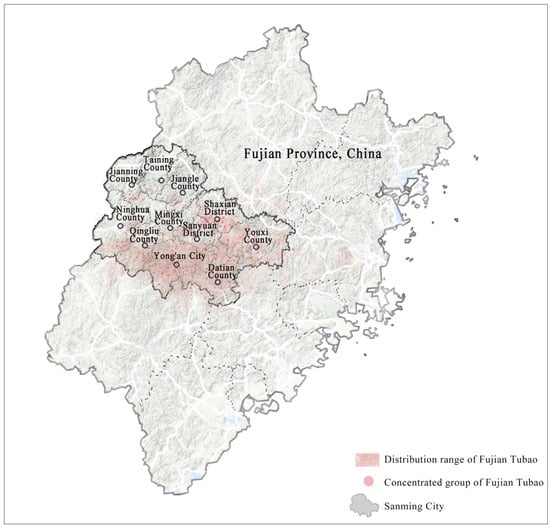
Figure 1.
Distribution of Fujian Tubao.
Historically, Fujian Province has been located on the southeastern coastal frontier of China. Its geographical distance from the political center of the Central Plains largely shielded it from large-scale warfare, making it a refuge for people fleeing conflicts. However, its remoteness from feudal centers of authority also meant weak imperial control, resulting in frequent disruptions to local social stability due to internal unrest, external invasions, and peasant uprisings [35]. While the region avoided large-scale wars, it experienced persistent localized turmoil. It was within this environment of unrest that Fujian Tubao emerged as a defensive architectural response. Fujian Tubao is composed of tall, solid outer walls and inner residential spaces arranged in courtyard or row house layouts. The outer walls primarily serve defensive functions, while the interior areas provide living space, with a clear distinction between defense and habitation. Prominent features of Fujian Tubao include its towering and massive rammed-earth walls, strong defensive capabilities, and unique architectural forms (Figure 2) [36].
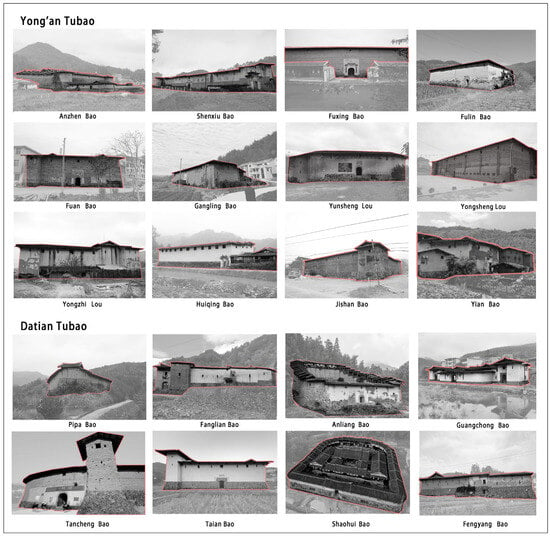
Figure 2.
Selected cases of Fujian Tubao.
3.2. Research Methodology
To achieve a deeper understanding and scientifically grounded assessment of the research problem, this study integrated a qualitative method of Grounded Theory with a quantitative method of AHP. Qualitative interview data were transformed into quantifiable and comparable value evaluation indicators (Figure 3). A rigorous quantitative method was then employed to determine the weight of each indicator, ensuring high-reliability research outcomes [37]. This study adopted a three-stage research pathway: qualitative exploration, indicator construction, and quantitative weighting, with the goal of constructing a comprehensive value evaluation system that could accurately reflect the value cognition of Fujian Tubao as architectural heritage.
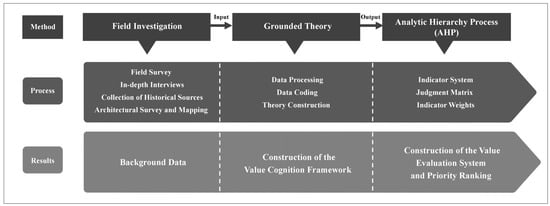
Figure 3.
Basic research framework.
First, following the procedural steps of Grounded Theory (Figure 4), in-depth interview data from fieldwork were coded in three stages. This process identified multiple dimensions of value perception related to Fujian Tubao and revealed the internal components of each value category. These findings were then structured into a hierarchical evaluation system consisting of a goal layer, a criterion layer, and an indicator layer. Next, the AHP method was used to assign weights to the indicators through expert-designed pairwise comparison matrices and questionnaires [38]. This allowed for the calculation of the relative importance of each indicator across all levels. The final system helps prioritize the multidimensional value of Fujian Tubao and serves as a scientific basis for future conservation practices and policy decisions.

Figure 4.
Procedural steps of Grounded Theory research.
This study carefully considered the epistemological differences and complementarities between Grounded Theory and the Analytic Hierarchy Process (AHP) during the transition from qualitative value identification to quantitative weight assignment. Grounded Theory follows an inductive logic, allowing value dimensions to emerge from empirical data in a bottom–up manner. As a result, the derived evaluation indicators are not arbitrarily predefined but are rooted in the lived context of Fujian Tubao and shaped by diverse stakeholder perspectives. This approach addresses a common limitation in conventional evaluation models, which often lack a solid theoretical foundation.
However, Grounded Theory alone primarily facilitates conceptual construction and lacks the capacity to quantitatively compare the relative importance of each value dimension within decision-making processes. To address this gap, AHP was introduced as a quantitative tool. AHP’s structured decision-making framework enabled the transformation of the complex, multifaceted value system identified through Grounded Theory into a hierarchical model. Experts were then invited to perform pairwise comparisons of the value elements, which had already been rigorously defined and interpreted through the qualitative phase. Although AHP inherently relies on expert judgment, the evaluation targets in this study were based on grounded empirical findings, thereby constraining subjective bias and enhancing logical coherence in the transition from “what the values are” to “how important each value is”.
Thus, the methodological integration adopted in this research is not a mere technical juxtaposition of methods. Rather, it represents a deliberate and coherent progression from qualitative discovery to quantitative analysis—anchored in epistemological reflection. This integrated approach enhances both the depth and applicability of the proposed value assessment framework for Tubao, ensuring that it is theoretically informed and practically relevant.
While the Analytic Hierarchy Process (AHP) provides a structured and systematic tool for addressing complex decision-making problems, it is important to critically reflect on its inherent limitations and clarify the strategies adopted to ensure methodological rigor and result credibility. One of the primary limitations of AHP lies in its strong reliance on expert judgment. The construction of pairwise comparison matrices is based entirely on experts’ experience and preferences, which can introduce subjective bias. To mitigate this issue, several measures were taken in this study. First, the expert panel was intentionally diversified, including professionals from academia, industry, and government sectors. This diversity was intended to balance potential cognitive biases by incorporating a broader range of perspectives. Second, all evaluation criteria were clearly defined based on the prior stage of Grounded Theory analysis. Standardized definitions were provided to ensure that all experts shared a consistent understanding when making judgments. In addition, AHP can encounter consistency challenges, particularly when the number of comparisons increases, leading to logical contradictions in expert judgments. To address this, consistency checks were conducted on both individual judgment matrices and the aggregated group matrix. This step ensured logical coherence across expert evaluations and reinforced the reliability of the final weighting results.
4. Constructing a Value Cognition Model Based on Grounded Theory
4.1. Data Collection
When constructing a value evaluation system based on the Grounded Theory, the authenticity, representativeness, and breadth of original data are essential to ensure the effectiveness of value coding. Core data for this study were obtained through in-depth interviews with target groups. Additionally, relevant local historical records, books, and official documents were collected through literature review methods and incorporated into the sample database as supplementary data, thereby ensuring the comprehensiveness of data sources. In-depth interviews adopted a semi-structured format. Prior to these interviews, an interview outline was developed based on preliminary analysis of the supplementary data, focusing on themes such as behavioral activities, value composition and connotation, heritage conservation, and respondent background. During interviews, discussions followed the outline. They were then gradually deepened to allow interviewees’ perspectives to emerge fully. Five categories of participants associated with Fujian Tubao were selected for in-depth interviews: Tubao residents, villagers in Tubao settlements, grassroots village officials, daily site managers, and scholars or experts (Figure 5), with a total of 45 individuals interviewed. The interviewed academic experts consisted of university faculty members, postgraduate students holding at least a master’s degree, and researchers engaged in heritage conservation work in Sanming City, Fujian Province. A total of 45 data samples were collected, of which 38 valid samples were confirmed after data cleaning. Of these, 30 were used for coding analysis, while the remaining 8 were reserved for theoretical saturation testing.

Figure 5.
Selection of interviewees for this study.
4.2. Data Coding
This study employed a three-stage coding procedure derived from the Straussian (procedural) Grounded Theory approach to analyze collected data samples. Data were processed through sequential stages of open coding, axial coding, and selective coding, followed by a saturation test, ultimately leading to the refinement of categories and the construction of a value cognition model. To enhance the reliability of this study, an inter-coder reliability test was conducted. Two researchers from the team collaboratively discussed the preliminary coding guidelines and category definitions prior to the coding process. Based on this consensus, transcripts of four interviews were randomly selected and independently coded by the two researchers. An inter-coder reliability check was subsequently conducted, yielding an agreement rate of over 80% between the two coders across the coded units. This indicates a high level of consistency in their interpretation and application of the coding framework. Minor discrepancies identified during the process were resolved by performing an in-depth discussion and revisiting the original data and coding definitions to reach consensus. Based on these adjustments, the coding scheme was slightly refined to ensure accuracy in the subsequent analysis. Remaining interview data were coded by one of the primary researchers, guided by the agreed upon and validated coding framework. The objective of this data coding analysis was to identify the value-type composition and interpret the underlying value connotations of Fujian Tubao architectural heritage.
Open coding constituted the first stage of analysis. In this phase, this study adopted an open-minded and non-prejudiced approach, avoiding prior assumptions while labeling key expressions that could reflect value-related characteristics. Similar labels were initially grouped into concepts, which were then further aggregated into categories [39]. The purpose was to systematically, inductively, and objectively identify core concepts and preliminary categories related to the research phenomenon from raw data [40]. Using NVivo 20, each relevant interview (Table 1) sample was examined line by line through close reading, reflection, inductive categorization, and constant comparison, resulting (Table 2) in 563 labels (aax), 75 concepts (ax), and 14 categories (Ax).

Table 1.
Examples of open coding excerpts.

Table 2.
Summary of open coding results.
Axial coding was the second stage of data coding. It involved re-integrating and re-categorizing the results of open coding, identifying and establishing logical relationships among categories [41]. Based on this process, similar categories were further merged and clustered to form core categories. Through the axial coding process, 14 previously identified categories were consolidated into five core categories (Table 3).

Table 3.
Summary of axial coding results.
Selective coding was the final stage of data coding [42]. It involved integrating core categories to identify an overarching core category that encapsulated the entire theoretical framework. Through further analysis of the five core categories and the 14 subcategories, it was found that historical value, artistic value, scientific value, social value, and cultural value collectively constituted the comprehensive value of Fujian Tubao architectural heritage. The 14 subcategories represented specific internal elements of these five value types. As a result, this study identified the “Value Cognition System of Fujian Tubao Architectural Heritage” as its core category (Figure 6).
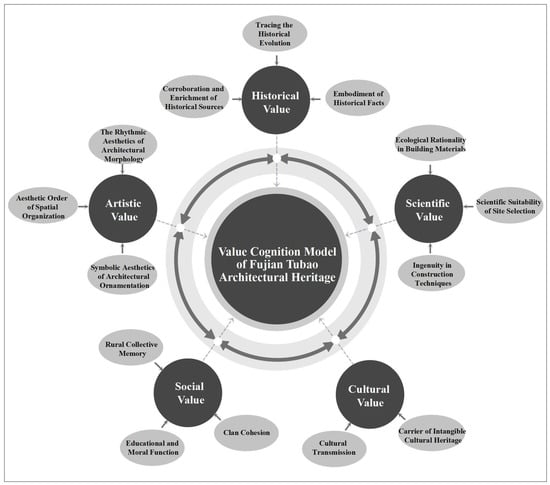
Figure 6.
Value cognition framework of Fujian Tubao architectural heritage.
During the coding process of Grounded Theory, it became evident that different stakeholder groups held distinct perceptions and priorities regarding the value of Fujian Tubao as architectural heritage. This highlights that heritage value is not a fixed or singular concept but a complex construct shaped by multiple perspectives.
Tubao residents, as the most direct users and experiential subjects of the architecture, perceive the heritage through the dual lens of a lived home and a defensive fortress. They place particular emphasis on historical value related to narrative continuity and on the social value associated with sustaining clan relations. Villagers in Tubao settlements, who live within the same community, display a highly localized and utilitarian understanding of value. They prioritize the role of heritage in preserving rural memory and upholding traditional cultural beliefs such as feng shui and ancestral worship. For them, Tubao functions as both a social bond among neighbors and a tangible witness to the village’s historical development. Experts, as knowledge authorities, focus more on the intrinsic architectural attributes of the Tubao. Their evaluations emphasize historical authenticity, artistic uniqueness, and scientific significance, viewing heritage as an objective carrier of historical information. Compared to ordinary villagers, grassroots village officials and daily site managers have undergone specialized training, engaged with experts, and assumed responsibility for site operations. As a result, their value perceptions are similarly aligned with the internal dimensions of heritage value, particularly, historical, artistic, and scientific aspects.
4.3. Theoretical Saturation Test
To ensure the scientific rigor of the Grounded Theory analysis process and the validity of its results, a theoretical saturation test was conducted. In this study, the eight reserved data samples were reanalyzed through processes of open coding, axial coding, and selective coding. Results of the theoretical saturation test indicated that no new concepts or categories emerged from the additional data. Therefore, it was concluded that the conceptual model developed in this study had reached theoretical saturation.
5. Construction of a Value Evaluation System and Weight Analysis Based on AHP
5.1. Hierarchical Structure of the Value Evaluation System
This study employed the AHP to perform a weight analysis of the architectural heritage value indicators of Fujian Tubao. AHP is a systematic and hierarchical decision-making method that integrates both qualitative judgment and quantitative computation. It has been proven to be highly effective and practical in addressing complex decision-making problems. This standard procedure involves four key steps: constructing a hierarchical structure model, establishing pairwise comparison matrices, calculating priority weight vectors with consistency testing, and deriving the final composite weight vector [43].
Based on the value cognition system of Fujian Tubao architectural heritage derived from the Grounded Theory, the heritage value evaluation criteria established in the Principles for the Conservation of Heritage Sites in China (2015), and the expert consultation results, this study adhered to the principles of mutual independence and comprehensive coverage. A comprehensive analysis of the historical, artistic, scientific, social, and cultural values of Fujian Tubao architectural heritage led to the identification of five criteria-level indicators (Level B) and 14 indicator-level indicators (Level C), resulting in the establishment of a value evaluation index system for Fujian Tubao architectural heritage (Table 4).

Table 4.
Value evaluation index system for Fujian Tubao architectural heritage.
This study invited seven experts and scholars with long-term research experience in Fujian Tubao to participate in the construction and refinement of the evaluation framework [44,45,46,47]. Pairwise comparison values for each heritage value indicator were assigned using expert judgment, forming the basis for the judgment matrix and subsequent weight calculations. To ensure the reliability of results, selection of the expert panel followed rigorous criteria. The expert panel included associate professors from universities, researchers from academic institutions, senior practitioners involved in heritage policymaking and engineering evaluation, and officials from governmental heritage management departments. This composition ensured the diversity of the perspectives and a balance between theoretical insight and practical experience.
All seven experts had established academic reputations and significant achievements in the field. They possessed substantial practical experience in heritage evaluation, architectural conservation, or local policy development, which endowed them with strong professional judgment and credibility.
A group decision-making approach was adopted in this study, wherein the seven experts evaluated the indicators. A subjective weighting method was used, assigning scores to each expert based on their educational background, professional title, years of experience, and familiarity with the indicator system. These scores were then normalized to derive individual expert weights, which were then incorporated into the calculation of indicator weights. Scoring criteria are detailed in Table 5.

Table 5.
Expert scoring criteria.
Subjectively assigned weights of each expert were compiled to form a weight matrix, where “i” was the “i-th” evaluation indicator, and “j” was the “j-th” expert.
The vector of expert weights “WZ” was obtained by summarizing according to Table 5. T was the sum of the total scores of all experts’ subjective assignments.
WZ = [w1 w2 …]T
The weight matrix was multiplied with expert weights WZ to obtain the integrated weight vector of all indicators “W”:
W = WZW’ = [ W1, W2, W3, W4, …, Wn]
Results of evaluating the information obtained from the seven experts are shown in Table 6.

Table 6.
Expert evaluation results.
5.2. Expert Group Decision-Making Hierarchical Analysis Weight
This study applied the AHP to determine the weights of evaluation indicators. The specific procedures are as follows:
(1) Constructing the Hierarchical Structure Model
Based on the established evaluation framework, the system under assessment was divided into three levels: the goal level, the criterion level, and the indicator level.
(2) Constructing the Pairwise Comparison Matrix
The pairwise comparison matrix is a fundamental component of the AHP. It involves comparing elements within the same hierarchical level in pairs and assigning relative importance values. Typically, a 1-to-9 scale is used to express comparative judgments of elements. The detailed meaning of each scale point is presented in Table 7.

Table 7.
Judgment matrix element comparison scale table.
By judging every two elements in the matrix one by one according to the scale shown in Table 7 above, an n-order comparison judgment matrix “A” can be obtained.
n-order judgment matrix
(3) Aggregating Expert Judgment Matrices
The geometric mean method was used to aggregate the judgment matrices provided by “k” experts (k = 1, 2, …, m). Specifically, for each element in the matrix, corresponding elements from all “m” expert matrices were multiplied together, and then the “m-th” root was taken. This resulted in a single integrated judgment matrix, where each element represented the geometric mean of the corresponding elements from individual matrices. The formula is shown as follows:
(4) Calculating the Relative Weight of the Judgment Matrix
The geometric mean method (square root method) was used to calculate the weight of the integrated unique matrix. The formula is shown as follows:
Calculation steps:
- Multiply elements of each row in the judgment matrix “” to obtain a new vector;
- Take the “n-th” root of each component in the resulting vector (where n is the order of the matrix);
- Normalize the resulting vector to obtain the final weight vector.
(5) Consistency Check of the Judgment Matrix
In the process of pairwise comparison by experts, inconsistency in judgments may inevitably occur. Therefore, it is essential to perform a consistency check on the constructed judgment matrix to ensure the rationality and validity of the derived weights.
In academic practice, the Consistency Ratio (CR) is commonly used to evaluate the consistency of a judgment matrix. CR is defined as the ratio of the Consistency Index (CI) to the Random Index (RI). If CR is less than 0.1, the matrix is considered to have acceptable consistency, and no modification is required. However, if CR is equal to or higher than 0.1, the judgment matrix must be revised by experts until the calculated CR is below 0.1.
The formula for calculating CR is shown in Equation (4):
where is the maximum eigenvalue of the judgment matrix. Its calculation formula is as shown in Formula (5).
is the maximum eigenvalue of the matrix, where “” is the judgment integration matrix, W is the weight vector, and [W]i is the i-th component of the matrix [W].
The RI value is associated with the order of the matrix. Its specific values are listed in Table 8.

Table 8.
The average random consistency index RI value of the judgment matrix.
5.3. Determination of Indicator Weights in the Value Evaluation System
5.3.1. Weight Calculations for Primary-Level Indicators
Weight calculations of first-level indicators began with seven experts rating five indicators using the predefined evaluation scale. Based on these ratings, individual pairwise comparison matrices were constructed. Subsequently, relevant results were calculated using procedures and formulas outlined earlier (Formulas (1)–(5)). Given the number of participating experts and the complexity of the evaluation indicators, this paper selected Expert 1’s ratings of first-level indicators as an illustrative example. Based on Expert 1’s assessments of indicators B1 to B3, the corresponding judgment matrix is shown in Table 9.

Table 9.
Judgment matrix for first-level indicators by Expert 1.
① According to the above table, we obtained a comparison judgment matrix “A”.
② Multiplying elements of “A” row by row, we obtained a new vector “B”.
③ Raising each component of the new vector “B” to the third power, we obtained the eigenvector “M”.
④ Normalizing the obtained vector “M”, we obtained the weight vector “W”.
⑤ The maximum eigenvalue λmax was then calculated as follows.
⑥ Consistency test of judgment matrix CI was then performed.
Calculation results are shown in Table 10.

Table 10.
Expert 1 indicator calculation results.
Repeating the above operation for the scoring matrix of the remaining six experts, calculations of the first-level indicators of the six experts were then performed. Results are shown in Table 11.

Table 11.
Summary of primary indicators.
Weights of the first-level indicators (B1)–(B5) were calculated. After ensuring that the judgment matrices from all seven experts met the consistency requirement (CR < 0.1), a total of seven judgment matrices were then aggregated according to Formula (2). The aggregated matrix is shown in Table 12.

Table 12.
Aggregated judgment matrix for B1–B5.
According to Formulas (3)–(5), the weight and consistency of the B1–B5 integration matrix were calculated. Results of B1–B5 weight and consistency calculations are shown in Table 13.

Table 13.
B1–B5 weight calculation results.
5.3.2. Weight Calculation for Secondary-Level Indicators
According to the same calculation steps of the first-level indicators, the judgment integration matrix and weight calculation results of the second-level indicators were obtained as follows.
Weights of the second-level indicator layer C1–C3 indicators were calculated. After ensuring that the judgment matrix of the seven experts met the consistency requirement (CR < 0.1), judgment matrices of the seven experts were aggregated according to Formula (2). The aggregated matrix is shown in Table 14.

Table 14.
Judgment matrix for C1–C3.
According to Formulas (3)–(5), the weight and consistency of the C1–C3 integrated matrix were calculated. Results are shown in Table 15.

Table 15.
C1–C3 weight calculation results.
Based on the above calculation process, each group of secondary indicators C4–C6, C7–C9, C10–C12, and C13–C14 was integrated into a matrix for weight and consistency calculation. Results of weight and consistency calculations are shown in Table 16.

Table 16.
Weights and consistency ratios of the remaining secondary indicators.
Final weights of the first-level and second-level indicators were sorted out to obtain evaluation indicator weights for this paper, as shown in Table 17.

Table 17.
Weights of all indicators.
5.3.3. Sensitivity Analysis
To assess the robustness of the criterion-level weight allocation in the proposed value evaluation framework for Fujian Tubao, sensitivity analysis was conducted on the two most heavily weighted dimensions: B1—Historical Value (initial weight = 0.4452) and B2—Artistic Value (initial weight = 0.3068). Each of these criteria was subjected to perturbations of ±10% and ±20% relative to their original weights. During each adjustment, the remaining criteria—B3 (Scientific Value), B4 (Social Value), and B5 (Cultural Value)—were proportionally scaled to ensure that the sum of all criteria weights remained equal to 1. Following each adjustment, the global weights of all five criteria were recalculated to observe any changes in their relative rankings. The results revealed that when B1 was varied within the range of 0.3562 to 0.5342, the overall ranking of criteria remained unchanged (B1 > B2 > B3 > B4 > B5). Similarly, varying B2 within the range of 0.2454 to 0.3682 also preserved the original ranking order.
These findings suggest that the proposed evaluation framework demonstrates strong robustness and resistance to perturbations in key weights. The consistency of the ranking order across a ±20% fluctuation range highlights the framework’s reliability and stability, particularly for informing conservation prioritization and decision-making in heritage management. Nonetheless, we recommend that future applications of this model consider contextual calibration of weights to further ensure appropriateness and precision.
6. Discussion
6.1. Interpretation of Value Cognition
6.1.1. Historical Value
(1) Tracing historical evolution. The development of Fujian Tubao is closely intertwined with the socio-political environment of central Fujian. The construction of Tubao reflects local needs for security, clan-based systems, and social organization. Studying its historical trajectory enables a deeper understanding of social transformations not only within Fujian but also across the tri-provincial border region of Fujian (Min), Jiangxi (Gan), and Guangdong (Yue)—hereafter referred to as the Min–Gan–Yue region. This research also offers valuable historical supplementation to local historiography. More specifically, Fujian Tubao serves as a tangible record of the political, economic, and cultural development of central Fujian. It provides material evidence essential for investigating socio-political conditions of the Ming and Qing dynasties and for tracing the historical evolution of defensive architecture throughout the Min–Gan–Yue region [48].
(2) Corroboration and enrichment of historical sources. Due to its early period of construction, long historical span, and location within a key region of ethnic migration and integration in Chinese history, the Fujian Tubao architectural heritage provides physical spaces that could serve as material carriers for a number of socially significant historical events [49]. Fujian Tubao itself functions as a “living historical archive”, offering critical physical evidence for historical events that are absent from written records. Through architectural entities, supplementary documents, and archaeological remains, the Tubao corroborates macro-level historical developments, such as wartime changes in Fujian during the War of Resistance against Japan, the spread of Red Army revolutionary movements, and social unrest along the southeastern coast during the Ming and Qing dynasties. It also helps restore micro-level details such as local self-defense activities and the transmission of construction techniques.
(3) Embodiment of historical facts. Fujian Tubao as a tangible form of material cultural heritage from the Ming and Qing dynasties is fundamentally characterized by its ability to directly record historical facts—an attribute that distinguishes it from ordinary architecture. Historical information embedded within the architectural body fully reflects the building’s own historical development over time. In terms of explicit textual documentation, many decorative components of Fujian Tubao contain inscriptions or notations indicating the date of construction, construction background, names of builders, and even the financial cost. Although many Tubao structures have suffered severe damage or undergone significant restoration, traces of such textual records are often found among architectural remains. Compared with historical texts—which are prone to loss, omission, or factual error—scientifically verifiable data extracted from physical architectural heritage can provide more authentic and stable historical information. As a result, it offers reliable evidence to corroborate and supplement written historical sources [50]. In addition to the physical structure, genealogical records associated with Fujian Tubao also constitute a valuable component of historical heritage. These records often provide detailed documentation of the construction date, original scale (Table 18), subsequent renovations across generations, and related historical events, serving as an important textual supplement to the tangible heritage.

Table 18.
Records of Fujian Tubao in selected clan genealogies.
6.1.2. Artistic Value
(1) Rhythmic aesthetics of architectural morphology. The highly visual and artistic architectural morphology is the most prominent manifestation of the artistic value of Fujian Tubao. Variation in the plan morphology of Fujian Tubao was determined by topographical characteristics of the site and the scale of construction. Square-shaped forts (Figure 7) typically occupy smaller plots, while large-scale Tubao structures often adopt a front-square and rear-circular configuration. Irregularly shaped Tubao are usually built on mountaintops or riverbanks, exhibiting asymmetrical forms that are highly integrated with the natural landscape. A vertical rhythmic layering of spatial volumes constitutes a key expression of the artistic character of architectural morphology. This sense of rhythm stems from the Tubao’s adaptive utilization of mountainous terrain. The elevation system—comprising the base, walls, and roof—follows the natural slope. It is arranged perpendicular to contour lines, producing a stepped layout that ascends from front to back and enhances the overall sense of vertical progression.
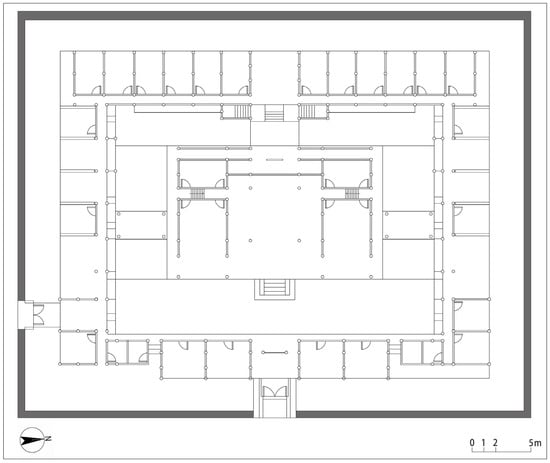
Figure 7.
Plan of a typical square-shaped Fujian Tubao.
(2) Aesthetic order of spatial organization. Chinese traditional architectural philosophy emphasizes a high degree of consistency in spatial organization, ranging from vernacular dwellings to imperial palaces [51]. These structures typically follow a courtyard-centered layout. Building upon this foundational model, Fujian Tubao expands outward from a central axis, gradually forming large-scale communal residences characterized by multi-layered courtyards along the front-rear axis and multiple flanking wings on either side. This generates a rich hierarchy of spaces from the exterior to the interior. Fujian Tubao follows the traditional Chinese ethical order of axial symmetry and centrality as superiority, which profoundly influences the spatial hierarchy (Figure 8).
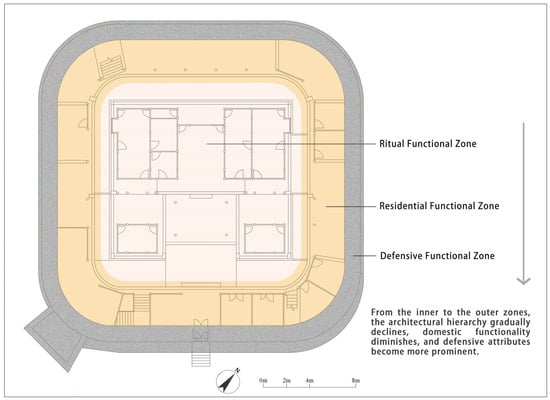
Figure 8.
Functional layout diagram of Yunsheng Lou in Yong’an City.
Spatial axes of Tubao are generally composed of one primary longitudinal axis and several secondary axes extending in both longitudinal and transverse directions (Figure 9). The primary axis is the central axis of the Tubao. The most important architectural spaces of the entire complex are arranged along the primary axis. Secondary axes do not exhibit a clear spatial hierarchy. Subordinate buildings are arranged along them to emphasize the ethical principle of centrality [52].
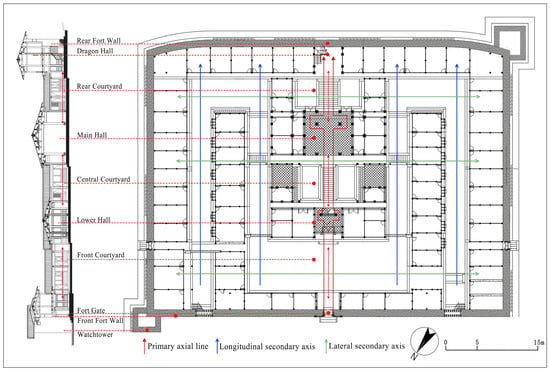
Figure 9.
Spatial axis analysis of Shenxiu Bao in Yong’an City.
(3) Symbolic aesthetics of architectural ornamentation. The construction philosophy of Fujian Tubao not only emphasizes the strength of its external defensive systems but also demonstrates great craftsmanship in shaping its interior living spaces, particularly through refined execution of architectural ornamentation. Ornamentation in the form of wood carving and stone carving is commonly found throughout Tubao [53], often employing auspicious motifs such as “bamboo heralding peace” and “peony symbolizing wealth”. In specific functional spaces such as ancestral halls and studies, components such as door panels and beam structures are often elaborately decorated with motifs drawn from idioms, classical literary works, and traditional themes such as music, chess, calligraphy, and painting, reflecting cultural refinement and value orientation. Ridge purlins are often adorned with Kui dragon motifs or branching peony patterns, conveying aspirations for a harmonious life, peace, and prosperity [54]. In addition to auspicious motifs, painted decorations also feature symbolic representations such as “Three Friends of Winter” and “Four Gentlemen” (plum, orchid, bamboo, and chrysanthemum), which reflect the moral integrity of the literati and serve to encourage younger generations within the Tubao to pursue scholarly excellence.
6.1.3. Scientific Value
(1) Scientific suitability of site selection. Site selection is fundamental to the construction of a settlement environment. Located in mountainous forests of central Fujian, Fujian Tubao sites are carefully selected based on natural factors such as geology, hydrology, and climate to ensure both residential comfort and defensive advantage [55]. By leveraging the surrounding natural environment, Tubao occupies strategically defensible terrain while simultaneously creating a livable and harmonious interior space. Construction principles of Fujian Tubao emphasize an interconnected, harmonious, and organic relationship between humans and nature. These principles involve understanding internal mechanisms of natural ecology, making rational use of environmental resources, and preserving the spatial structure and vitality of the natural landscape. By creating vertically layered spatial systems with varied elevations, Tubao maximizes the performance of natural lighting (Figure 10), ventilation, and drainage [56]. Ecological adaptability demonstrated in the construction of Fujian Tubao in response to mountain–water patterns is a product of traditional Chinese feng shui philosophy [57]. The site selection, orientation, layout, and spatial scale of Fujian Tubao strictly adhere to feng shui principles, aiming to harness advantages of nature while avoiding its potential hazards.
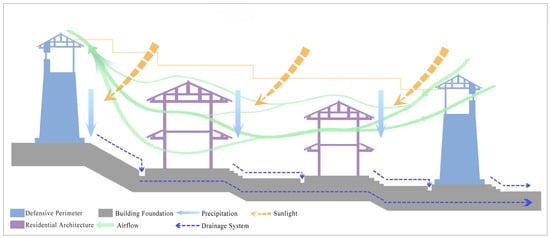
Figure 10.
Design diagram of ventilation, lighting, and drainage in Fujian Tubao.
(2) Ingenuity in construction techniques. Fujian Tubao as a representative example of defensive architecture in China demonstrates remarkable ingenuity in construction techniques during a time of limited scientific and technological advancement. It makes full use of physical properties of natural materials and adopts rational spatial arrangements integrated with human design wisdom to skillfully resolve challenges such as insufficient structural bearing capacity, low wall strength (Figure 11), and inadequate defensive performance. These solutions offer valuable references for constructing modern regional architecture.
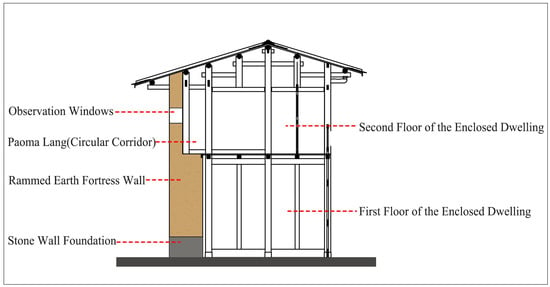
Figure 11.
Sectional elevation of the fort wall at Shenxiu Bao, Yong’an City.
(3) Ecological rationality of building materials. The central Fujian region is characterized by dense forests, narrow valleys, and limited accessibility via land or water, resulting in relatively weak connections with external areas. For a long time, traditional agriculture served as the dominant mode of subsistence, fostering a self-sufficient mindset shaped by contentment, attachment to the land, and reluctance to relocate [58]. Under this influence, construction of Fujian Tubao became closely intertwined with the region’s vernacular mountain-and-forest culture. As a result, building materials were selected based on the principle of local availability, primarily utilizing native earth, timber, stone, and river sand (Table 19). This practice has resulted in the naturally simple and modest architectural form that defines Fujian Tubao [59].

Table 19.
Common building materials used in Fujian Tubao.
6.1.4. Social Value
The social value of architectural heritage lies in its multidimensional role as a physical vessel and a spiritual link. The Principles for the Conservation of Heritage Sites in China define social value as the significance and benefits of cultural heritage in recording and disseminating knowledge, transmitting cultural spirit, and fostering social cohesion. As a form of clan-based residential architecture reflecting social conditions of the Ming and Qing dynasties, the architectural heritage of Fujian Tubao plays a unique social role in preserving and reinforcing local memory, shaping ideological values, and strengthening clan unity.
6.1.5. Cultural Value
Under the dual influence of clan-based Confucian culture from Central Plains and indigenous traditions of Fujian, Fujian Tubao possesses cultural value in both conveying regional culture and embodying intangible cultural heritage formed under diverse cultural backgrounds [60]. As a tangible expression of forest culture, feng shui beliefs, and Zhuzi (Neo-Confucian) philosophy in central Fujian, the architectural heritage of Fujian Tubao serves as an important case for regional cultural studies. Over its long historical development, a wide array of folk customs and ritual practices have accumulated and become embedded in Tubao, giving rise to a rich body of folk culture. As such, Tubao functions as a material carrier of the region’s intangible cultural heritage and provides a physical space for the continuation of traditional craftsmanship and folk activities.
6.2. Analysis of Value Indicator Weights
Based on the AHP, this study calculated weights of the value evaluation system for the architectural heritage of Fujian Tubao. The resulting weight structure is not merely a numerical ranking [61] but rather a quantified reflection of internal relationships and hierarchical structure among Tubao’s multiple attributes, offering a key perspective for understanding its nature as a “Holistic Heritage”. A structured model is established, consisting of five value types (criterion level) and 14 specific value indicators (indicator level). Evaluation results clearly revealed differences in relative importance among various value types within the overall expert cognition framework, thereby forming a well-defined sequence of value conservation priorities.
6.2.1. Weight Analysis of Historical Value (B1)
Within the criterion level, Historical Value (B1) represents the most essential attribute of the architectural heritage of Fujian Tubao. Its weight (0.4452) was significantly higher than that of other value categories, making it the central pillar of the evaluation system. This result indicates that Fujian Tubao as a form of historical architectural heritage is particularly distinguished by its capacity to convey historical narratives and bear documentary evidence. In the collective perception of experts, the primary value of architectural heritage lies in its role as tangible “material evidence” directly linked to specific historical periods. Within the historical value dimension, the core element was the embodiment of historical facts (C3), which had the highest relative weight of 0.6541, ranking first within the historical value group. This underscores the critical role of architectural heritage in directly recording and reflecting historical information. Corroboration of historical sources (C2) ranked second with a relative weight of 0.1991, highlighting the contribution of Fujian Tubao to “filling documentary gaps” and “supporting historical validation”. This weight reflected expert recognition of the Tubao’s potential to complement existing textual sources. Tracing historical evolution (C1) ranked third within the same group, indicating that the origin and transformation of Fujian Tubao could provide meaningful support for understanding the broader regional history and the evolution of local social structures.
From the perspective of critical heritage studies, the high weighting assigned to historical value might reflect an implicit bias among expert groups—namely, the assumption of “the older the heritage, the greater its value”. This tendency might inadvertently overshadow other value dimensions, particularly the contemporary significance of intangible or spiritual meanings. Therefore, while the results of this study are contextually valid within current evaluation frameworks, it remains essential to maintain a critical stance toward value hierarchies at the methodological level. Future research should consider expanding the composition of expert panels and diversifying their disciplinary backgrounds to enhance the credibility and inclusiveness of heritage value assessments.
6.2.2. Weight Analysis of Artistic Value (B2)
Artistic Value (B2), with a weight of 0.3068, ranked second at the criterion level. The unique architectural language and visual expressiveness of Fujian Tubao constitutes one of its core strengths and a major source of its cultural appeal. Artistic attributes are manifested through three indicators: Architectural Morphology (C4), Spatial Organization (C5), and Architectural Ornamentation (C6), all of which reflect the material value of the architectural entity itself. Architectural Morphology (C4) contributed 0.6453 to B2, making it the dominant component within this category. This highlights the distinctive aesthetic features and visual impact of Fujian Tubao’s overall form, particularly in its façade composition and plan configuration. Spatial Organization (C5) had a relative weight of 0.2072. This reflects how the layered spatial rhythm and well-ordered axial layout of Fujian Tubao demonstrate its rarity and uniqueness as an architectural type. Architectural Ornamentation (C6) ranked third in relative weight, indicating that experts tended to view decorative elements as concentrated expressions of aesthetic preferences, craftsmanship, and cultural symbols of their respective historical periods.
6.2.3. Weight Analysis of Scientific Value (B3)
Scientific Value (B3) ranked third at the criterion level. In terms of indicator weights, it was significantly lower than the top two value types. However, as a reflection of traditional construction wisdom and environmental adaptability, it holds empirical research value for modern architectural practice. Scientific principles and technical strategies embedded in Tubao are not only important subjects in architectural history research but also offer insights for the sustainable development of contemporary architecture. Scientific value is primarily reflected in three indicators: site environment (C7), construction techniques (C8), and building materials (C9), which ranked second, first, and third, respectively, within this category. The distribution of weights within this value dimension revealed that experts, when evaluating scientific value, prioritized core construction techniques while also recognizing the importance of environmental adaptability and material application.
6.2.4. Weight Analysis of Social Value (B4) and Cultural Value (B5)
In the current evaluation, the weights of Social Value (B4) and Cultural Value (B5) were 0.0986 and 0.0624, respectively. Both were significantly lower than those of the top three value categories. This reflected an expert perspective in which extrinsic and derivative values were given lower priority and importance for conservation compared to intrinsic core values directly associated with the architectural entity itself. Although these weight values were relatively low, such a result did not imply the absence of social and cultural value. Rather, it indicates that social and cultural connotations are more often integrated into and reflected through other value dimensions, such as historical, artistic, and scientific value. Compared to those dimensions, the uniqueness of social and cultural values is relatively less pronounced. At the same time, the relatively low weights assigned to these two value dimensions might not necessarily indicate their lower intrinsic importance. Instead, they might have resulted from disciplinary biases or the composition of the expert panel during the evaluation process. When making pairwise comparisons, experts might tend to prioritize values that are quantifiable and physically tangible, leading to more definitive judgments. Moreover, expert participants might be professionally trained and experienced primarily in assessing material and technical aspects of architectural heritage, which could have influenced the underrepresentation of social and cultural values. Future research could mitigate such structural bias by incorporating a broader range of stakeholders into the evaluation process.
The value assessment framework constructed in this study revealed a clear hierarchical structure in the relative importance of various value dimensions and their specific manifestations through AHP analysis. This prioritization offers critical guidance for architectural heritage conservation by elucidating the relative significance of different value types and, more importantly, by identifying key conservation targets associated with each dimension. Abstract value categories are thus translated into tangible spatial or cultural components, enabling targeted preservation strategies and reducing the risk of vague or generalized protection efforts. The quantified priority ranking further facilitated the identification of the most scarce, vulnerable, or irreplaceable value elements, thereby informing policy decisions to focus on the most critical conservation priorities. This is especially vital in contexts of limited financial resources and competing preservation needs, where such a framework ensures that efforts and funding are allocated to those elements that are most difficult to preserve and are least substitutable.
6.3. Case Study Analysis of the Value Assessment Framework
To explore the potential applicability of the proposed value assessment framework in practical scenarios, this study took Fuxing Bao in Yong’an City, Fujian Province, China, as a case context. Drawing on the heritage value cognition model, five categories of value elements were identified, with particular emphasis on refining high-weighted dimensions and their specific manifestations. The synthesized findings aimed to offer conceptual guidance for subsequent conservation planning at Fuxing Fort, including funding allocation, intervention strategies, spatial repair sequencing, and policy development.
In terms of funding priorities, limited resources could be directed toward uncovering and safeguarding the fort’s historical documentation—such as archival records, genealogical manuscripts, and stone inscriptions—with a focus on systematic organization and digital presentation. Regarding intervention strategies, a differentiated approach could be adopted based on value rankings. For core spaces associated with highly weighted dimensions, minimal intervention and restoration to the original condition are suggested in order to preserve structural integrity. Secondary spaces might allow for moderate adaptive reuse aligned with practical needs. In architectural repair, high-priority areas—such as the ancestral hall, central courtyard, and commemorative steles—might be addressed first, followed by gradual expansion to peripheral corridors, ancillary rooms, and residential units, thus forming a tiered restoration sequence. From a policy perspective, evaluation results could serve as a reference for developing hierarchical management mechanisms, regulatory zoning, and heritage designation proposals. Overall, the proposed value assessment framework shows promise in guiding heritage conservation practices, with the potential to enhance both decision-making efficiency and transparency, particularly in resource-constrained contexts.
7. Conclusions
This study conducted a systematic evaluation and weight analysis of the architectural heritage value of Fujian Tubao by integrating the Grounded Theory with the Analytic Hierarchy Process (AHP). It not only clarifies the composition and hierarchical relationships of its multidimensional value system but also offers critical insights and targeted guidance for its future conservation and adaptive reuse.
7.1. Clarifying Conservation Targets: From Macro-Level Value Dimensions to Specific Elements
At its surface, heritage conservation involves preserving physical artifacts, architectural entities, surrounding blocks, or even larger urban areas. However, the ultimate focus lies in safeguarding the value of architectural heritage itself. Only by clarifying specific components of architectural heritage value can one determine the precise content, priorities, and spatial focus of conservation, thereby enabling the formulation of targeted measures such as maintenance and restoration interventions [62]. The value evaluation system for the architectural heritage of Fujian Tubao developed in this study not only clarifies the macro-level direction of “what values should be protected”, but also further identifies specific objects and elements that require focused conservation efforts. By referencing value manifestations indicated by high-weight indicators in the evaluation results, the most critical conservation targets and spatial elements within the dimensions of historical, artistic, and scientific value are identified, thereby avoiding vague conservation scopes and the dispersion of resources. This precise positioning—from macro-level value dimensions to micro-level elements—can enhance the specificity of conservation efforts. By constructing a theoretical framework of value cognition, it establishes a value-centered conservation philosophy for Fujian Tubao and provides guidance for government decision-making in policy planning, spatial protection, and adaptive reuse.
7.2. Establishing Value Prioritization: Implications for Heritage Conservation Resource Allocation
This study established a prioritized sequence of value dimensions and specific indicators for Fujian Tubao through quantitative weight analysis. Findings of this study offer critical guidance for addressing current challenges in the conservation of Fujian Tubao architectural heritage, particularly the limited funding and the dispersion of conservation efforts. Prioritization results provide a practical basis for staging conservation interventions and allocating financial resources according to a tiered structure. By constructing a three-level model—“core value, key value, general value”—this research proposes a value-oriented resource allocation framework tailored to decision-making practice, thereby enhancing the precision and efficiency of efforts in research investment, fiscal support, structural restoration, and adaptive reuse. This study clarifies both “what should be protected” and “what should be prioritized for protection” in the conservation of Fujian Tubao, offering a theoretical reference for heritage authorities in formulating restoration and adaptive reuse strategies.
(1) Prioritizing Conservation Interventions. Building upon the value assessment framework, a scoring matrix that integrates both conservation and development dimensions could be constructed to quantitatively evaluate the composite value of different Fujian Tubao sites. This would enable horizontal comparisons of their relative value levels, supporting government decision-making in terms of annual funding allocation and conservation intensity. Such prioritization ensures that limited resources are directed toward the most valuable and endangered sites. For large-scale Tubao structures, where restoration efforts require long-term and sustained commitment, the framework can help identify high-weighted value areas for early technical investment, thereby enhancing the precision of funding interventions.
(2) Formulating Targeted Conservation Strategies. Through the value cognition framework, site managers could be guided to develop tailored restoration and protection plans based on specific value expressions. For example, strategies focusing on scientific value should prioritize the protection of technical elements at the normative level, such as site selection rationale, construction methods, and building materials, ensuring both technical preservation and landscape integrity.
(3) Assessing Adaptive Reuse Proposals. Adaptive reuse remains a crucial approach in the conservation of traditional architecture. When evaluating reuse options for Fujian Tubao, the proposed framework can be used to assess the potential impact of different strategies on the integrity of multiple heritage values, thereby determining whether specific value dimensions might be compromised during the reuse process.
(4) Heritage Monitoring and Risk Forecasting. Key value indicators identified within the framework could serve as focal points for long-term monitoring. Variations in these indicators could provide early warning signals of potential risks to the architectural heritage, supporting proactive conservation responses.
It enhances the precision and rationality of decision-making. By identifying specific conservation targets and adopting a core-priority strategy, this study provides a framework for achieving efficient protection and precise intervention under limited resource conditions, thereby enabling Fujian Tubao to serve as a valuable cultural asset that continues to enrich the contemporary society.
7.3. Limitations and Future Research Directions
This study proposed an architectural heritage value assessment framework that integrated Grounded Theory with the Analytic Hierarchy Process (AHP), offering a theoretical reference for the conservation of Fujian Tubao. However, due to limitations in the research team’s disciplinary background and time constraints, several issues in both design and application stages merit further discussion. First, the Grounded Theory component primarily relied on conventional data sources such as field interviews, the literature, and policy documents. To improve data comprehensiveness, future studies should consider expanding the data sources and increasing the sample diversity. Second, the AHP analysis involved a relatively limited number of experts (n = 7). Although the selected participants possessed strong academic and professional credentials, greater representativeness and disciplinary diversity could enhance the robustness of our findings. Third, the current framework remains largely conceptual. It has not yet been applied in real-world heritage management scenarios involving policy implementation, resource distribution, or conservation prioritization. As such, its practical validity and adaptability remain to be tested.
Future research may consider the following directions for further exploration. First, as this study focuses on quantifying experts’ objective background attributes, the Delphi method—typically used to integrate subjective judgments and build consensus—was not adopted. Nevertheless, we acknowledge that incorporating Delphi-based triangulation could serve as an important enhancement to improve the methodological rigor of the evaluation system in future research. Second, future studies should aim to increase the number of interviewees and questionnaire responses to improve the accuracy and representativeness of the findings. Third, the proposed value evaluation system may be applied to other types of architectural heritage with different cultural contexts—such as vernacular dwellings in Yunnan, Huizhou residential architecture, and Beijing siheyuan—to further test its generalizability. Fourth, future research may also integrate more diverse data sources to expand the identification of value dimensions. Additional dimensions such as economic value and functional value could be incorporated to construct a more comprehensive architectural heritage evaluation model.
Author Contributions
Conceptualization, X.Q. and M.C.; methodology, X.L. and X.Q.; software, M.C.; validation, X.Q. and W.Y.; formal analysis, X.Q. and W.Y.; investigation, X.L. and W.Y.; resources, X.L.; data curation, M.C. and X.Q.; writing—original draft preparation, W.Y.; writing—review and editing, X.Q. and W.Y.; visualization, X.Q.; supervision, X.L. and X.Q.; funding acquisition, M.C. All authors have read and agreed to the published version of the manuscript.
Funding
This research received no external funding.
Data Availability Statement
The original contributions presented in this study are included in the article. Further inquiries can be directed to the corresponding author.
Conflicts of Interest
The authors declare no conflicts of interest.
References
- Qin, Q.; Xiao, D.; Ma, J.; Tao, J. Using graphic comparison to explore the dynamic relationship between social conflicts and Fujian Defense-Dwellings in China. J. Asian Archit. Build. Eng. 2021, 21, 2285–2305. [Google Scholar] [CrossRef]
- Dai, Z. The Fujian Earthen Fort and the Fujian Earth Building Construction Shape Debates Differently. China Anc. City 2012, 4, 50–55. [Google Scholar]
- Pan, K.H. Study on the Earth Fortress in Fujian. Master’s Thesis, Tsinghua University, Beijing, China, 2010. [Google Scholar]
- Zhao, Y.; Luo, Z.; Huang, K. Characterization of public space forms in traditional Chinese villages based on spatial syntax: Zhangli village as an example. J. Asian Archit. Build. Eng. 2024, 23, 1–22. [Google Scholar] [CrossRef]
- Xu, S. A Study on the Value of Architectural Heritage in the Zhongshan Road Historical and Cultural District, Shilong, Dongguan. Master’s Thesis, South China University of Technology, Guangzhou, China, 2023. [Google Scholar]
- Zhang, Y.; Chen, S. A methodological study on the value analysis of celebrity former residence heritage buildings: A case study of several former residences in Qingdao. China Cult. Herit. 2020, 3, 83–93. [Google Scholar]
- Chen, H.; Zhou, Y.; Zhang, P. Value Perception and Willingness to Pay for Architectural Heritage Conservation: Evidence from Kumbum Monastery in China. Buildings 2025, 15, 1295. [Google Scholar] [CrossRef]
- Kee, S. A Study on the Trends of Acceptance Criteria of the Relocation of Architectural Heritages and Priority Values of Monuments in Seoul. Sustainability 2022, 14, 8404. [Google Scholar] [CrossRef]
- Xu, Y.; Rollo, J.; Esteban, Y.; Tong, H.; Yin, X. Developing a Comprehensive Assessment Model of Social Value with Respect to Heritage Value for Sustainable Heritage Management. Sustainability 2021, 13, 13373. [Google Scholar] [CrossRef]
- Fredheim, L.H.; Khalaf, M. The significance of values: Heritage value typologies re-examined. Int. J. Herit. Stud. 2016, 22, 466–481. [Google Scholar] [CrossRef]
- Hung, H.; Yau, Y. On the assessment of social value of heritage places in Hong Kong. J. Asian Public Policy 2022, 17, 469–483. [Google Scholar] [CrossRef]
- Augustiniok, N.; Houbart, C.; Plevoets, B.; Van Cleempoel, K. Adaptive reuse of built heritage: Conserving and designing with values. J. Cult. Herit. Manag. Sustain. Dev. 2025, 15, 24–41. [Google Scholar] [CrossRef]
- Burgos Vargas, C.; Mora Alonso-Muñoyerro, S. About the validity of Alois Riegl’s the Modern Cult of Monuments. J. Archit. Conserv. 2022, 28, 183–196. [Google Scholar] [CrossRef]
- Wu, L. Studies in the History of Industry and Technology; Science Press: Beijing, China, 2018. (In Chinese) [Google Scholar]
- Hua, Y.; Chun, Q.; Jin, H. Research on Collapse Modes and Bearing Capacities of Ancient Chinese Stone Arch Bridges Built with Different Stone Arrangements. Int. J. Archit. Herit. 2020, 16, 553–576. [Google Scholar] [CrossRef]
- de la Torre, M. Values and Heritage Conservation. Herit. Soc. 2013, 6, 155–166. [Google Scholar] [CrossRef]
- Della Spina, L. Adaptive Sustainable Reuse for Cultural Heritage: A Multiple Criteria Decision Aiding Approach Supporting Urban Development Processes. Sustainability 2020, 12, 1363. [Google Scholar] [CrossRef]
- Arrighi, C.; Masi, M.; De Lucia, C.; Castelli, F. Prioritizing risk for cultural heritage through social value: A participatory framework. Int. J. Disaster Risk Reduct. 2025, 93, 105627. [Google Scholar] [CrossRef]
- Salehipour, M.; Kazemi, N.; Jokar Arsanjani, J.; Karimi Firozjaei, M. Developing a Multi-Criteria Decision Model to Unlock Sustainable Heritage Tourism Potential. Sustainability 2025, 17, 3703. [Google Scholar] [CrossRef]
- Davies, O.O.A.; Brisibe, W.G.; Imaah, N.O.; Daminabo, F.F.O. A multi-criteria approach to assessing the revival of heritage through adaptive reuse: The case study of Fagbewesa’s House in Osogbo, Osun State, Nigeria. Int. J. Archit. Herit. 2025, 8, 1–17. [Google Scholar]
- Lin, Y. Fundamental Theoretical Research on the Conservation of Chinese Architectural Heritage. Doctoral Dissertation, Xi’an University of Architecture and Technology, Xi’an, China, 2007. [Google Scholar]
- Yu, J. A discussion on the value of cultural heritage. Sci. Technol. Assoc. Forum 2011, 3, 185–186. [Google Scholar]
- Qin, H. On the value components of architectural cultural heritage. China Anc. City 2013, 7, 18–22+26. [Google Scholar]
- Xu, J. A renewed understanding of the architectural heritage value system. China Anc. City 2018, 4, 71–76. [Google Scholar]
- Gao, F. Value Assessment of the Industrial Heritage of the Chinese Eastern Railway from the Perspective of Heritage Corridors. Ph.D. Thesis, Harbin Institute of Technology, Harbin, China, 2018. [Google Scholar]
- Han, B.; Luo, Z. Evaluation of Subsoil Modulus for the Value of Architectural Heritage. Huazhong Archit. 2010, 6, 116–118. [Google Scholar]
- Song, G.; Yang, C. Re-Examining on the Value Assessment System of Modern Architectural Heritage. Archit. J. 2013, S2, 198–201. [Google Scholar]
- Qiu, G.; Yu, D. Cultural and artistic characteristics of Sanming Tubao architecture and its digital preservation. Theory Res. 2009, 28, 156–158. [Google Scholar]
- Dai, Z. The present and future of Fujian Tubao: Summary of the National Academic Symposium on Fujian Tubao, China. New Archit. 2011, 5, 130–137. [Google Scholar]
- Wang, H.; Yan, W. A study on the conservation strategies for Shuimei Tubao Cluster in Shaxian, Fujian from a multidimensional value perspective. Fujian Wen Bo 2024, 1, 44–50. [Google Scholar]
- Fayez, H. From ‘Objects’ to ‘Sustainable Development’: The Evolution of Architectural Heritage Conservation in Theory and Practice. Buildings 2024, 14, 2566. [Google Scholar] [CrossRef]
- Pastor Pérez, A.; Barreiro Martínez, D.; Parga-Dans, E.; Alonso González, P. Democratising Heritage Values: A Methodological Review. Sustainability 2021, 13, 12492. [Google Scholar] [CrossRef]
- Susemihl, G. Ideas, Concepts and Uses of Heritage. In Claiming Back Their Heritage. Heritage Studies; Springer: Cham, Switzerland, 2023. [Google Scholar]
- Klamer, A. The values of cultural heritage. In Handbook on the Economics of Cultural Heritage; Ginsburgh, V.A., Throsby, D., Eds.; Edward Elgar Publishing: Cheltenham, UK, 2013; pp. 421–437. [Google Scholar]
- Porretta, P.; Pallottino, E.; Colafranceschi, E. Minnan and Hakka Tulou. Functional, Typological and Construction Features of the Rammed Earth Dwellings of Fujian (China). Int. J. Archit. Herit. 2022, 16, 899–922. [Google Scholar] [CrossRef]
- Qiao, X. Inheritance and Evolution: Research on the Activation Design of Fuxing Bao in Yong’an City. Master’s Thesis, Jiangxi University of Finance and Economics, Nanchang, China, 2023. [Google Scholar]
- Xu, Y.; Zhang, F. A study on the evaluation system of urban brand image based on grounded theory and the analytic hierarchy process (AHP). Ind. Innov. Res. 2024, 15, 88–90. [Google Scholar]
- Fan, J.; Zheng, B.; Liu, J.; Tian, F.; Sun, Z. Research on Child-Friendly Evaluation and Optimization Strategies for Rural Public Spaces. Buildings 2024, 14, 2948. [Google Scholar] [CrossRef]
- Liu, Z.; Zhao, X.; Long, W. Mechanism of consumers’ purchase intention under livestream e-commerce: A grounded theory analysis. China Bus. Mark. 2020, 34, 48–57. [Google Scholar]
- Wang, T.; Zhou, L.; Zhou, N.; Mou, Y.; Xie, Z. How is the image of a country of origin formed? A grounded study based on American and Indian consumer evaluations and the theory of reasoned action. Manag. World 2012, 3, 113–126. [Google Scholar]
- Che, J.; Su, W.; Bai, L.; Guo, H. A Grounded Theory Approach to the Influence Mechanism of Residential Behavior among Mongolian Yurt Dwellers in China. Buildings 2023, 13, 1268. [Google Scholar] [CrossRef]
- Zhang, M.; Zhang, J.; Liu, Q.; Li, T.; Wang, J. Research on the Strategies of Living Conservation and Cultural Inheritance of Vernacular Dwellings—Taking Five Vernacular Dwellings in China’s Northern Jiangsu as an Example. Sustainability 2022, 14, 12503. [Google Scholar] [CrossRef]
- Alvarenga, A.D.; Salgado, E.G.; de Sousa Mendes, G.H. Ranking criteria for selection of certification bodies for ISO 9001 through the Analytic Hierarchy Process (AHP). Int. J. Qual. Reliab. Manag. 2018, 35, 1321–1342. [Google Scholar] [CrossRef]
- Liu, W.; Liu, S. Construction of group decision judgment matrix in AHP. Syst. Eng. Electron. 2005, 11, 93–94+99. [Google Scholar]
- Liu, Y.; Zhang, B.; Qin, J.; Zhu, Q.; Lyu, S. Integrated Performance Assessment of Prefabricated Component Suppliers Based on a Hybrid Method Using Analytic Hierarchy Process–Entropy Weight and Cloud Model. Buildings 2024, 14, 3872. [Google Scholar] [CrossRef]
- Huang, J.; Song, Y.; Sheng, Y.; Zhang, Y.; Hu, D. Restorative Potential Assessment of Public Open Space in Old Urban Communities in the Context of Aging—A Case Study of Dabeizhuang Community in Maanshan, China. Buildings 2024, 14, 2671. [Google Scholar] [CrossRef]
- Duan, X.; Lin, B.; Meng, L.; Zhao, F. A Method for Selecting and Optimizing Pocket Park Design Proposals Based on Multi-Attribute Decision Making. Buildings 2025, 15, 1026. [Google Scholar] [CrossRef]
- Zhang, Y.; Li, W.; Cai, X. A cultural geography study of the spatial art and cultural features of the interior of Lingnan ancestral halls in the Ming and Qing dynasties. J. Asian Archit. Build. Eng. 2023, 22, 3128–3140. [Google Scholar] [CrossRef]
- Tang, X.; Zhang, J.; Xu, S. Scale Level Characterization of Waterside Landscape in Dongjiang River Delta. South Archit. 2023, 4, 89–95. [Google Scholar]
- Zhao, H. A Study on the Value of Ancestral Hall Architectural Heritage in Dongguan. Master’s Thesis, South China University of Technology, Guangzhou, China, 2022. [Google Scholar]
- Ke, K. A Comparative Study on the Regional Characteristics of Rammed-Earth Dwellings in Northern Shaanxi and Southern Fujian. Master’s Thesis, Xi’an University of Architecture and Technology, Xi’an, China, 2011. [Google Scholar]
- Lin, X.; Lin, S.; Li, C.; Li, C. A study on the spatial characteristics of Fujian Tubao from the perspective of architectural ethics. Chin. Overseas Archit. 2021, 8, 125–128. [Google Scholar]
- Zhang, M.; Li, H.; Liu, Q. Research on the Characteristics of Timber Frames in Traditional Residences in North Jiangsu Province of China. Int. J. Archit. Herit. 2025, 19, 1–17. [Google Scholar] [CrossRef]
- Lou, J. A comprehensive overview of Fujian Tubao architecture. Fujian Wen Bo 2009, 35–44, 96–97. [Google Scholar]
- Liu, W.; Li, T.; Chen, X. Research on the evolution of urban defense in song dynasty based on shouchenglu 守城录(Record of urban defense). J. Asian Archit. Build. Eng. 2024, 24, 1094–1111. [Google Scholar] [CrossRef]
- Chen, W. A Study on the Spatial Form and Typological Design of Minzhong Tubao. Master’s Thesis, Huaqiao University, Quanzhou, China, 2010. [Google Scholar]
- Zhang, S. The heritage practices in a Chinese historic neighbourhood: The manifestation of traditional Feng Shui in Langzhong, China. Int. J. Herit. Stud. 2017, 24, 531–546. [Google Scholar] [CrossRef]
- Dai, Z. Fujian Vernacular Dwellings; China Architecture & Building Press: Beijing, China, 2009; p. 45. [Google Scholar]
- Wang, X.; Fang, K.; Chen, L.; Furuya, N. The influence of atrium types on the consciousness of shared space in amalgamated traditional dwellings—A case study on traditional dwellings in Quanzhou City, Fujian Province, China. J. Asian Archit. Build. Eng. 2019, 18, 335–350. [Google Scholar] [CrossRef]
- Lin, X.; Wu, Y. Architectural Spatial Characteristics of Fujian Tubao from the Perspective of Chinese Traditional Ethical Culture. Buildings 2023, 13, 2360. [Google Scholar] [CrossRef]
- Gui, W.; Zhang, T.; Cui, D. A comparative study on walking accessibility of high-speed railway station areas in China and Japan based on analytic hierarchy process—Beijing station and Osaka station as examples. J. Asian Archit. Build. Eng. 2024, 24, 540–553. [Google Scholar] [CrossRef]
- Li, N. A Study on the Architectural Heritage Value of Dazhao Temple in Inner Mongolia. Master’s Thesis, Inner Mongolia University of Technology, Hohhot, China, 2019. [Google Scholar]
Disclaimer/Publisher’s Note: The statements, opinions and data contained in all publications are solely those of the individual author(s) and contributor(s) and not of MDPI and/or the editor(s). MDPI and/or the editor(s) disclaim responsibility for any injury to people or property resulting from any ideas, methods, instructions or products referred to in the content. |
© 2025 by the authors. Licensee MDPI, Basel, Switzerland. This article is an open access article distributed under the terms and conditions of the Creative Commons Attribution (CC BY) license (https://creativecommons.org/licenses/by/4.0/).

